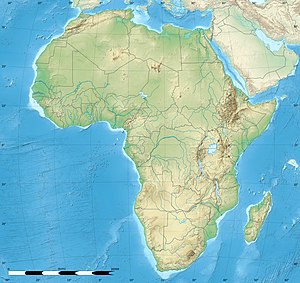8°50′18″S 13°14′04″E / 8.83833°S 13.23444°E
Luanda | |
|---|---|
Panoramic view of Luanda Bay | |
| Coordinates: 8°50′18″S 13°14′4″E / 8.83833°S 13.23444°E | |
| Country | |
| Province | Luanda |
| Founded | 25 January 1576 |
| Area | |
| 116 km2 (45 sq mi) | |
| • Metro | 1,876 km2 (724 sq mi) |
| Elevation | 6 m (20 ft) |
| Population (2022)[2] | |
| 2,831,280[1] | |
| • Metro | 9,079,811 |
| • Metro density | 4,800/km2 (13,000/sq mi) |
| 2022 | |
| Demonym(s) | Luandan; luandense (Portuguese) |
| Time zone | UTC+01:00 (West Africa Time) |
| • Summer (DST) | (Not Observed) |
| HDI (2019) | 0.697[3] Medium |
Luanda (/luˈændə, -ˈɑːn-/, Portuguese: [luˈɐ̃dɐ]) is the capital and largest city of Angola. It is Angola's primary port, and its major industrial, cultural and urban centre. Located on Angola's northern Atlantic coast, Luanda is Angola's administrative centre, its chief seaport, and also the capital of the Luanda Province. Luanda and its metropolitan area is the most populous Portuguese-speaking capital city in the world and the most populous Lusophone city outside Brazil. In 2020 the population reached more than 8.3 million inhabitants (a third of Angola's population).
Among the oldest colonial cities of Africa, Luanda was founded in January 1576 as São Paulo da Assunção de Loanda by Portuguese explorer Paulo Dias de Novais, being occasionally called "Leonda" or "St Paul de Leonda" by non-portuguese sources. The city served as the centre of the slave trade to Brazil before the institution was prohibited.
At the start of the Angolan Civil War in 1975, most of the white Portuguese left as refugees,[4] principally migrating to Portugal. Luanda's population increased greatly from internal refugees fleeing the war, but its infrastructure was inadequate to handle the increase. This also caused the exacerbation of slums, or musseques, around Luanda.
In the 21st century, the city has been undergoing a major reconstruction.[5] Many new large developments are taking place that will alter its cityscape significantly.
Industries present in the city include the processing of agricultural products, beverage production, textile, cement, new car assembly plants, construction materials, plastics, metallurgy, cigarettes and shoes. The city is also notable as an economic centre for oil,[6][7] and a refinery is located in the city.
Luanda has been ranked as one of the most expensive cities in the world for expatriates.[8][9] The inhabitants of Luanda are mostly members of the ethnic Ambundu people. In recent decades of the 21st century, the number of ethnic Bakongo and Ovimbundu have also increased. Ethnic Europeans are mainly Portuguese.
Luanda was the main host city for the matches of the 2010 African Cup of Nations.
- ^ Instituto Nacional de Estatística, República de Angola.
- ^ "Angola: Administrative Division (Provinces and Municipalities) - Population Statistics, Charts and Map". Archived from the original on 2018-02-12. Retrieved 2018-02-12. Citypopulation reporting on Instituto Nacional de Estatística, República de Angola (web) projection July 2019
- ^ "Sub-national HDI – Area Database – Global Data Lab". hdi.globaldatalab.org. Archived from the original on 2018-09-23. Retrieved 2018-09-13.
- ^ Cite error: The named reference
:0was invoked but never defined (see the help page). - ^ "Luanda - Angola Today". Angola Today. Archived from the original on 2017-04-20. Retrieved 2017-04-19.
- ^ Guardian Staff (2019-01-22). "After the oil boom: Luanda faces stark inequality – photo essay". The Guardian. ISSN 0261-3077. Archived from the original on 2019-06-15. Retrieved 2019-06-15.
- ^ Specter, Michael (2015-05-25). "Luxury Living in a Failed State". The New Yorker. ISSN 0028-792X. Archived from the original on 2019-01-09. Retrieved 2019-06-15.
- ^ "Luanda most expensive city for expats". 2017-06-21. Archived from the original on 2019-02-23. Retrieved 2019-06-15.
- ^ Neild, Barry (2018-06-26). "Most expensive city for expats revealed". CNN Travel. Archived from the original on 2019-05-30. Retrieved 2019-06-15.









